A Modified RBF Collocation Method for Solving the Convection-Diffusion Problems
Abstract
The main purposes of this study are to propose the modified radial basis function (RBF) collocation method using a hybrid radial basis function to solve the convection-diffusion problems numerically and to choose the optimal shape parameter of radial basis functions. The modified numerical scheme is tested on a benchmark problem with varying shape parameters. The root mean square error and maximum error are used to validate the accuracy and efficiency of the method. The proposed method can be a good alternative to the radial basis function collocation method to improve accuracy and results.
1. Introduction
The convection-diffusion problem is important in many branches of science and engineering governed by the convection-diffusion equation [1–5]. The convection-diffusion equation is a fundamental equation that combines convection and diffusion processes to represent the problem process. When dealing with complex geometry, the analytical method is difficult to use, but the numerical methods have been tackled [6–9]. However, it is well known that the solution to this problem becomes oscillatory when the convection-diffusion problem becomes a convection-dominated problem, meaning the coefficient in the diffusion part is very small. In this convection-dominated problem, a thin boundary layer (there is a very high gradient) is usually formed if the standard numerical procedure is performed without special treatments. Standard numerical methods are also limited in the geometric domain. Moreover, the solution to this problem presents a challenging computational task.
The numerical methods known as radial basis function (RBF) collocation methods have been proposed and attracted by researcher because these methods do not require a mesh generation to discretize the problem domains [10–19]. Typically, these methods are based on the collocation techniques, and the computing process of the methods is efficient and accurate when only the Dirichlet boundary conditions exist [20]. However, for a large number of collocation points in a domain, these methods may have a major shortcoming when they are applied to solve the Neumann boundary conditions. Furthermore, the computing process leads to the ill-conditioned problem, and several approaches have been proposed to solve this problem [21–33]. A main tool of the RBF collocation techniques is RBF, which is used to approximate the solution of the partial differential equations (PDEs). Chuathong et al. [34, 35] have proposed the effectiveness of several well-known and mostly used RBFs to solve the nonlinear class of partial differential equations. In addition, it is found that the Cubic Matérn RBF type produces “the best results” quality for all test cases, whereas the Gaussian RBF produces “worst results” quality. For the interpolation of large points, however, the typical RBF forms lead to large and ill-conditioned systems. To avoid this limitation, Mishra et al. [36] have proposed a new RBF that combines the Gaussian and cubic types. They found that the proposed RBF significantly improved the condition number of the matrix system. Also, the ill-conditioned problems are treated by Kansa’s method using the proposed RBF for application in several benchmark problems: 1D, 2D, and 3D. Recently, this method using a hybrid RBF has gained popularity in many fields of science and engineering, and it has been used to solve large data approximations [37–39]. This immediately raises the question of whether this newly invented RBF can be applied to the problem of solving PDEs, specifically the convection-diffusion equation. This motivates the author to modify the RBF collocation technique in order to solve the convection-diffusion problem and alleviate the ill-conditioned problems. Furthermore, the convection-dominated problem is expected to be solved more effectively.
In this article, the newly invented RBF [36] is applied to solve the convection-diffusion problem. While aspects of the hybrid RBF have been discovered, it is still mentioned in selecting the optimal shape parameter in the Gaussian part, which is not straightforward. This means that the choice of the shape parameter is specific. To remedy this case, the new hybrid is modified by adding weight to the Gaussian and cubic RBFs. The two RBFs are then combined. The weight is added to control the contribution of the Gaussian and cubic parts. Several possible combinations of both RBFs are investigated. The optimal weight is chosen in the interval (0, 1) using the minimum root mean square error. Solving the convection-diffusion problem using some traditional RBF collocation methods without special treatments is quite ill-conditioned; therefore, a new modified hybrid RBF on the RBF collocation scheme is proposed to solve the problems. As shown in the numerical results, applying the modified RBF collocation method significantly reduces the error in solving the convection-diffusion problem, especially when the diffusion coefficient is small.
The article is organized as follows. In Section 2, a brief conventional RBF collocation method for solving partial differential equations is introduced. In Section 3, the invented hybrid RBF of Mishra et al. [36] is introduced, and the difference between the Gaussian and cubic RBFs is briefly discussed. The advantages of both RBFs are employed to modify the hybrid RBF, and the traditional RBF collocation method is also modified for the convection-diffusion problem using the new modified hybrid RBF. In Section 4, to validate the proposed approach, the proposed RBF collocation method is applied to solve the convection-diffusion problem. Moreover, the results obtained by this method are compared to those obtained by exact solutions. Furthermore, to alleviate the convection-dominated problems and the difficulty of conditioning, the modified RBF collocation method using the various weights of the hybrid RBF is studied for different diffusion coefficients. Finding the optimal shape parameter of the Gaussian in a hybrid RBF is also discussed to obtain the best results. A short conclusion is drawn in Section 5.
2. The Radial Basis Function Collocation Methods (RBF Collocation Methods)
Let {x1, x2 ⋯ , xN} denote the set of collocation points, denote the set of interior points, and denote the set of boundary points where NI is the number of interior points and N is the total number of collocation points.
3. The Modified RBF Collocation Method
In this section, we apply a hybrid RBF [36] concept to the RBF collocation methods. RBFs are the main tools used in RBF collocation methods to approximate the unknown function using known data points. The RBF is defined as follows.
Definition 1. A function φ : ℝN⟶ℝ is said to be radial if there exists a univariate function ϕ : ℝ+⟶ℝ such that φ(x) = ϕ(r), r = ‖x‖, where ‖⋅‖ represents the Euclidean norm. Typical RBF and their expression are shown in Table 1.
| RBFs | Mathematical expression |
|---|---|
| Multiquadric |
|
| Inverse multiquadric |
|
| Gaussian |
|
| Thin plate spline | ϕ(r) = r2log(r) |
| Cubic | ϕ(r) = r3 |
| Wendland’s |
|
The stability and accuracy of the RBF interpolation depend on the aspects of the algorithm and the data involved.
The weight α is added to the hybrid RBF to control the contribution of the Gaussian and cubic parts. In addition, the accuracy of the hybrid RBF is affected by the type of problem and the collocation points. The weight α helps an ill-conditioned problem when the hybrid RBF uses a small shape parameter and alleviates the singular matrix in cubic part. This means that the collocation method using the hybrid RBF will produce better results in terms of accuracy. The optimal shape parameter ε and the weight α are chosen according to the minimum root mean square error.
Let {x1, x2, ⋯, xN} denote a set of collocation points in a domain Ω ∪ ∂Ω1 ∪ ∂Ω2, denote a set of interior points, and denote a set of boundary points on ∂Ω1 ∪ ∂Ω2.
The unknown coefficient matrix c is obtained by solving the system (15). Hence, for any xi ∈ Ω, the approximate solution can be found in equation (11).
4. Numerical Results
To illustrate the effectiveness of the proposed approach, the convection-diffusion equation is applied. Throughout this section, HybRBF denotes the hybrid RBF in (6), MHybRBF denotes the modified RBF in (7), GA denotes the Gaussian RBF, and CB denotes the cubic RBF.
| ρ | GA | Time | CB | Time | ||||
|---|---|---|---|---|---|---|---|---|
| RMSE | MAXE | CN | RMSE | MAXE | CN | |||
| 100 | 3.615045e-06 | 6.990812e-06 | 1.537902e+23 | 0.123355 | 1.470723e-07 | 3.059453e-07 | 4.684657e+11 | 0.116703 |
| 10 | 3.476547e-04 | 6.694427e-04 | 1.304255e+22 | 0.116527 | 1.428050e-05 | 3.034218e-05 | 5.151761e+10 | 0.179804 |
| 1 | 2.280170e-02 | 4.270190e-02 | 1.026336e+21 | 0.132901 | 1.109043e-03 | 2.366442e-03 | 1.191804e+10 | 0.122082 |
| 0.5 | 5.552731e-02 | 1.055118e-01 | 1.724032e+21 | 0.132075 | 3.293163e-03 | 7.376807e-03 | 1.054947e+10 | 0.122629 |
| 0.1 | 3.533230e-01 | 8.452437e-01 | 5.881338e+20 | 0.123835 | 5.047532e-02 | 1.422299e-01 | 6.712422e+10 | 0.118474 |
| 0.01 | 5.981820e-01 | 2.266399e+00 | 1.198877e+21 | 0.125228 | 3.421569e-01 | 1.458199e+00 | 3.078447e+11 | 0.125130 |
| 0.001 | 2.114194e-01 | 1.248382e+00 | 3.568844e+20 | 0.126839 | 1.732781e+01 | 7.510594e+01 | 1.602582e+13 | 0.124880 |
| 0.0001 | 4.240498e-01 | 2.052057e+00 | 6.242204e+21 | 0.114314 | 1.062712e+00 | 8.896234e+00 | 3.631293e+11 | 0.146026 |
| ρ | HybRBF | MHybRBF | ||||||
| RMSE | MAXE | CN | Time | RMSE | MAXE | CN | Time | |
| 100 | 7.705245e-06 | 1.434408e-05 | 7.463696e+12 | 0.122474 | 8.164123e-07 | 1.778744e-06 | 7.935031e+11 | 0.121252 |
| 10 | 6.449282e-04 | 1.200222e-03 | 7.820077e+11 | 0.134633 | 8.006966e-05 | 1.725578e-04 | 8.404555e+10 | 0.128443 |
| 1 | 2.337358e-03 | 4.480407e-03 | 1.454403e+11 | 0.140067 | 6.479810e-03 | 1.319792e-02 | 1.359125e+10 | 0.164191 |
| 0.5 | 5.209617e-01 | 1.127411e+00 | 1.149173e+11 | 0.132664 | 2.108005e-02 | 4.226807e-02 | 9.773317e+09 | 0.116316 |
| 0.1 | 5.209617e-01 | 1.127411e+00 | 3.183265e+11 | 0.114587 | 1.658683e-01 | 3.137132e-01 | 1.585630e+10 | 0.120703 |
| 0.01 | 3.210199e-01 | 8.306938e-01 | 4.371672e+11 | 0.115497 | 4.172998e-01 | 1.540322e+00 | 2.048141e+12 | 0.135795 |
| 0.001 | 4.251006e-01 | 1.577832e+00 | 4.997906e+11 | 0.114875 | 1.235107e+00 | 4.180278e+00 | 3.094705e+11 | 0.117116 |
| 0.0001 | 3.209438e+00 | 9.752944e+00 | 8.167756e+11 | 0.137506 | 5.994588e-01 | 2.263910e+00 | 1.955926e+11 | 0.118089 |
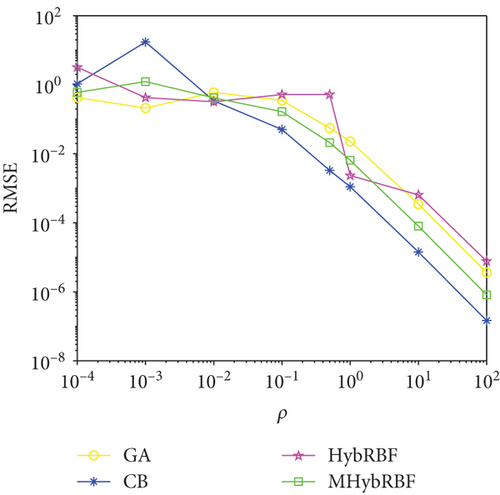
Let HybRBF2 and MHybRBF2 denote the HybRBF and MHybRBF using the optimal shape parameter, respectively. The value of the shape parameter ε of both RBFs is tested by varying the value between 0 and 100. In this investigation, MHybRBF and MHybRBF2 are computed with a specific α = 0.5.
Table 3 shows the results of HybRBF2 and MHybRBF2 using the optimal shape parameter for different diffusion coefficients ρ, and Figure 2 depicts the comparison of the RMSE of the collocation method using HybRBF, MHybRBF, HybRBF2, and MHybRBF2. It can be found that choosing the optimal shape parameter of HybRBF2 and MHybRBF2 is helpful. For different values of ρ in the convection-diffusion problem, the errors obtained by both HybRBF2 and MHybRBF2 decrease, which indicates that HybRBF2 and MHybRBF2 can perform well and improve the solution of the convection-diffusion problem with different diffusion coefficients ρ including the convection-dominated problem.
| ρ | HybRBF2 | CN | MHybRBF2 | CN | Time | |||||
|---|---|---|---|---|---|---|---|---|---|---|
| ε | RMSE | MAXE | Time | ε | RMSE | MAXE | ||||
| 100 | 2.45 | 1.538491e-08 | 5.205199e-08 | 1.311588e+12 | 0.169221 | 3.54 | 2.910194e-07 | 6.910851e-07 | 8.426454e+11 | 0.121009 |
| 10 | 2.49 | 1.168458e-06 | 4.199704e-06 | 1.536089e+11 | 0.120400 | 3.56 | 2.736761e-05 | 6.770259e-05 | 8.961082e+10 | 0.119983 |
| 1 | 3.00 | 2.337358e-03 | 4.480407e-03 | 1.454403e+11 | 0.112102 | 3.93 | 1.588563e-03 | 3.551225e-03 | 1.539699e+10 | 0.115826 |
| 0.5 | 18.00 | 3.857760e-03 | 7.847551e-03 | 2.209149e+06 | 0.226041 | 4.36 | 3.900101e-03 | 8.252530e-03 | 1.330964e+10 | 0.129819 |
| 0.1 | 9.45 | 1.294861e-03 | 3.710988e-03 | 9.744350e+09 | 0.113749 | 10.00 | 9.266198e-03 | 2.282203e-02 | 6.723776e+09 | 0.117170 |
| 0.01 | 2.71 | 3.140152e-01 | 7.836397e-01 | 3.216466e+11 | 0.188296 | 9.38 | 1.086233e-01 | 4.221994e-01 | 1.067272e+10 | 0.134580 |
| 0.001 | 3.97 | 1.962120e-01 | 9.497762e-01 | 1.337207e+11 | 0.177430 | 46.5 | 7.834417e-02 | 3.383703e-01 | 1.872398e+08 | 0.123130 |
| 0.0001 | 61.10 | 2.196106e-01 | 9.531780e-01 | 6.056237e+10 | 0.108612 | 47.59 | 1.760771e-01 | 1.287923e+00 | 1.014938e+08 | 0.115460 |
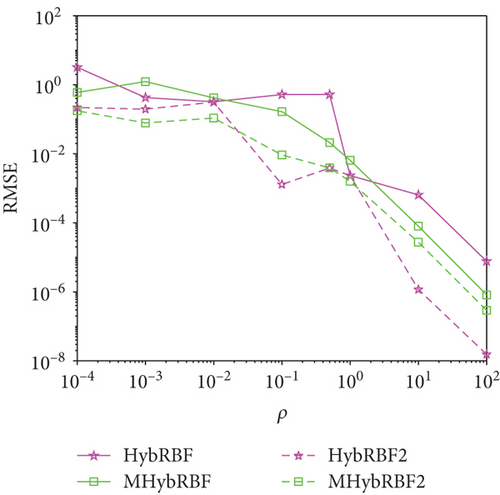
Moreover, the comparison of the collocation method using all six RBFs is discussed, and the RMSE of these methods is illustrated in Figure 3. It can be observed that the errors of the method using HybRBF2 and MHybRBF2 are quite smaller than those of the technique using other RBFs. It can also be found that, for different values of ρ, the proposed collocation method using MHybRBF, HybRBF2, and MHybRBF2 performs better than HybRBF. Furthermore, for ρ = 0.001, the approximate solutions obtained by applying MHybRBF and MHybRBF2 are compared and shown in Figure 4. As illustrated in Figure 4, MHybRBF2 provides the approximate solutions that agree with the exact solution, whereas MHybRBF still yields oscillatory solutions. In addition, in Tables 2 and 3, the CN of the matrix system is similar with or without the optimal shape parameter for the different values of ρ.
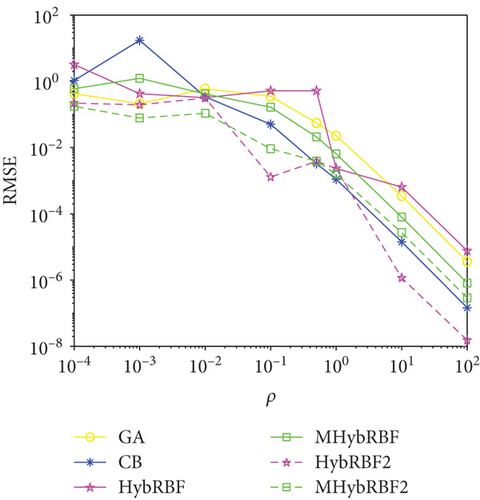
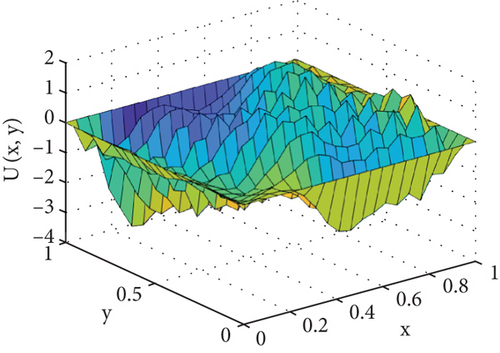
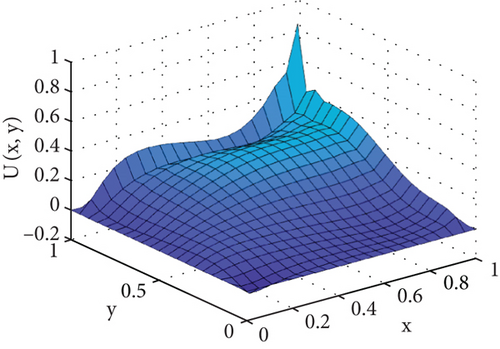
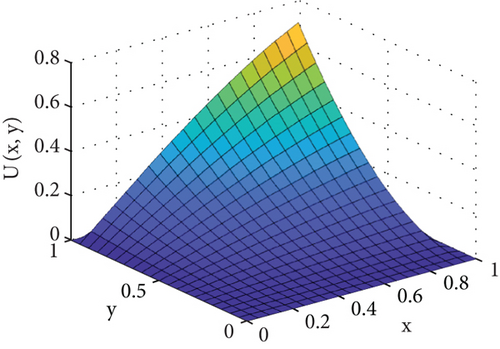
Although the proposed collocation method using MHybRBF yields slightly better results than those obtained by using HybRBF, both methods produce results that are not quite in good agreement with the exact solution, especially for a very small ρ. For example, when the proposed collocation method using MHybRBF is applied to ρ = 0.0001, the numerical results remain oscillatory and do not agree with those obtained by the exact solution, as shown in Figure 5(a). Therefore, for a very small diffusion coefficient ρ, finding the optimal weight α is discussed in depth to control the contribution of the hybrid RBF and improve the results of the MHybRBF. It can be seen in Table 4 that when the proposed approach is employed with the optimal values of ε and α, the errors obtained by this method decrease. This implies that the numerical results obtained by MHybRBF with the optimal weight α are improved and slightly agree with those obtained by the exact solution, as illustrated in Figures 5(b)–5(d).
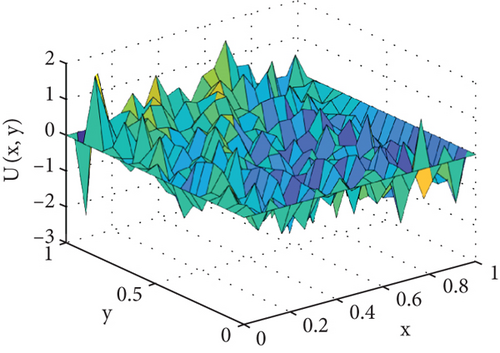
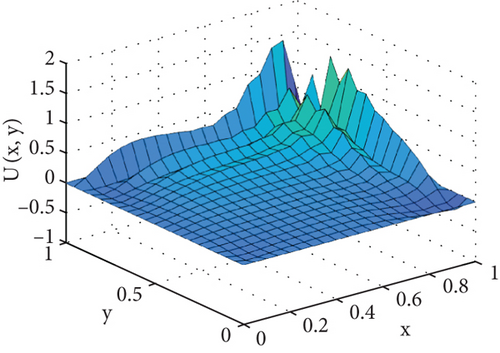

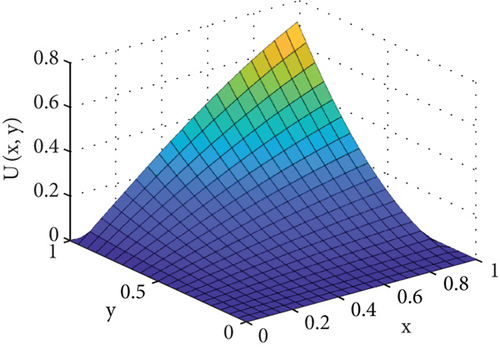
| ρ | α | ε | MHybRBF | Time | ||
|---|---|---|---|---|---|---|
| RMSE | MAXE | CN | ||||
| 100 | 0.56 | 3.54 | 4.848361e-06 | 6.972640e-06 | 3.408575e+12 | 0.120996 |
| 10 | 0.95 | 3.56 | 1.791690e-05 | 3.549015e-05 | 5.803703e+10 | 0.120914 |
| 1 | 0.95 | 3.93 | 9.070883e-04 | 1.876517e-03 | 1.343570e+10 | 0.133980 |
| 0.5 | 0.95 | 8.93 | 2.556100e-04 | 8.988170e-04 | 5.582259e+09 | 0.124727 |
| 0.1 | 0.9 | 9.03 | 2.804490e-03 | 8.193785e-03 | 1.128277e+10 | 0.114545 |
| 0.01 | 0.98 | 33.70 | 3.355029e-02 | 3.797075e-01 | 1.780515e+10 | 0.125761 |
| 0.001 | 0.93 | 46.49 | 4.263947e-02 | 1.883747e-01 | 6.525949e+09 | 0.118694 |
| 0.0001 | 0.95 | 58.5 | 1.655461e-01 | 8.865616e-01 | 1.677765e+11 | 0.111952 |
In addition, in Table 4, the optimal weight α used for MHybRBF is found to be about 0.95 for solving the convection-diffusion problem with each diffusion coefficient ρ. On the other hand, the discovered optimal shape parameter ε shows an increasing trend as the diffusion coefficient ρ decreases. Also, the CN does not change significantly.
5. Conclusion
In this paper, a modified RBF collocation method using a hybrid RBF is proposed for the numerical solution of the convection-diffusion problem. A hybrid RBF proposed by Mishra et al. [36] is further utilized in conjunction with the RBF collocation method, and some promising results are obtained. The advantages of the Gaussian and cubic RBFs are extended to modify the hybrid RBF by adding the extra weight which controls the contribution of the Gaussian and cubic RBFs. It is worth noting that when using the modified hybrid RBF, the quality of the results is significantly improved and agrees with the exact solution. However, the performance of the proposed method will be reduced when the problem has a very small diffusion coefficient or is a convection-dominated problem. This means that the numerical solutions obtained using this method are still oscillatory for a small diffusion coefficient. To improve the accuracy of the modified RBF collocation method using the hybrid RBF, finding the optimal shape parameter of the Gaussian part and the optimal weight of a modified hybrid RBF is discussed and found through a numerical experiment with the minimum root mean square error. The numerical study demonstrates that choosing the optimal shape parameter produces better results, and the obtained results are acceptable and agree with the exact solution. Moreover, the proposed scheme can overcome the convection-dominated problem (the instability issue), which is a challenging problem in science and engineering. It can also be noted that the optimal weight of the hybrid RBF plays an important role in the numerical solution to the convection-diffusion problem, especially the convection-dominated. Moreover, the combination of the Gaussian RBF and cubic RBF works well. Finally, when stability is considered, the CN obtained by the modified RBF collocation method does not differ significantly in solving the convection-diffusion problem with different diffusion coefficients. However, the proposed approach yields a lower CN than using only the Gaussian RBF.
In future work, the proposed scheme will be extended to solve other types of PDEs, including the modeling of both time-independent and time-dependent PDEs. Another important aspect to investigate concerns the study of the nodal distributed model: irregular points and refinement points. Furthermore, the combination of other RBFs is worth investigating.
Conflicts of Interest
The author declares that she has no conflicts of interest.
Acknowledgments
The authors would like to express their sincere gratitude and appreciation to King Mongkut’s University of Technology North Bangkok (Contract no. KMUTNB-62-NEW-14) for financial support. Our great appreciation is also expressed to the Faculty of Science, Energy and Environment and the King Mongkut’s University of Technology North Bangkok (Rayong Campus) for providing all the necessary facilities.
Open Research
Data Availability
The data used to support the findings of this study are included within the article.




